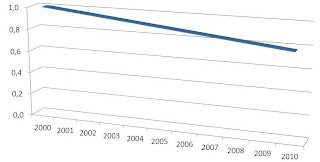Already at the end of 1996, an independent study, developed under the coordination
of Jaakko Pöyry, diagnosed serious insufficiencies in the primary sector
of forestry in Portugal. This was seen as a victim, simultaneously, of insufficient
use of its potential and of an increasing pressure to furbish the industrial sector,
worsened lately by the increasing demand for wood and biomass for energy
production.
The increasing gravity of this situation of underuse and over-exploitation
of forest areas limits a rational and sustainable utilization of Portuguese forest
resources, which could portend great negative impacts for future generations.
Portugal exports a large part of the goods produced from forest resources,
essentially to member states of the European Union, in particular to Spain,
France and Germany.
The maladjustment between demand and supply was, in 2011, the object of
public denouncement by the highest responsible figure of the National Forest
Authority, in foreseeing a situation of rupture in timber in less than 15 years.
In order to face the lack of resources, the country presently imports approximately
2 million cubic metres of wood, some of which cause the preoccupation of the
WWF insofar as their origin.
Faced with the constantly worsening situation in comparison with 1996, the
present government recently revealed a disconnected wager on forestation, in
particular in monocultures of fast-growing exotic species, concretely, of eucalyptus
(Eucalyptus globulus). However, national specialists, researchers and academics show that, according
to data from the latest forest inventories, there has been an increase in the
number of cases of deficiency or even absence of
forest management in the two principal Portuguese forest species, maritime pine
(Pinus pinaster) and eucalyptus. In the case of eucalyptus, the data
obtained may even signify a sharp increase of abandoned eucalyptus plantations
between 1992 and 2005.
According to specialists, the increase in production
of woody material from maritime pine and eucalyptus to supply the transformation
industries will not depend so much on the increase of their areas of occupation,
as was seen at the beginning of the last century and seems to be the option of
the present government. Instead, fundamentally, it will depend on the promotion
of active management of forest areas, with the intent to obtain greater
productivity per area. This priority is based on the fact that the numbers
related to productivities of 5 and 10 cubic metres annually per hectare,
respectively for maritime pine and for eucalyptus, have remained unchanged since
1928.
The absence of active management in a significant part of the Portuguese
forest area is at the origin of an easier spread of forest fires in Portugal, as
well as a more favourable propagation of pests and diseases. This fact is not unrelated to the increasing concentration
of industry and the lack of competition in the three main forest chains, both
that of the eucalyptus and of maritime pine but also that of the cork oak (Quercus
suber). Each of these chains is dominated by a specific entrepreneurial group.
At present, the authorities abstain from accompaniment of commercial relations
in the different forest industry chains, leaving farmers and forest owners (retainers
of approximately 90% of the forest area in Portugal) at the mercy of large industrial
monopolies.

The country has had the support, since 1989, of European Community funds
for forests. In this area, however, worrisome practical results have been
evident as well as degrees of success that are always lower than expected or
even ridiculous, such as those seen in the present period (2007/2013). Here, errant
strategies, namely with the laying of priorities on new forestation without
ensuring subsequent forestry management or adjustment to the markets, have
given rise to very preoccupying situations. In the most serious case, that of
the maritime pine, hundreds of millions of euros have already been consumed
(1989/2005) just for new forest plantations. However, although one would expect
the efforts of national and European taxpayers to generate thousands of new
hectares of maritime pine, through the attribution of non-reimbursed subsidies,
in reality there has been a move backward in terms of the area of this species,
in this time period, of about 400 thousand hectares. In parallel, in the period
between 1989 and 2005, the negative impact of forest fires in Portugal has
grown. Could the taxpayers’ money be promoting the forest fire “industry”?
It is not for lack of strategic documents that the problems persist. At
the moment, another one is being announced. Portugal has been prodigious in creating
strategic plans for forests, among them the Plan for Sustainable Development of
the Portuguese Forest (PDSFP) of 1997, or more recently the National Strategy for
Forests (ENF) of 2007. All have had irrelevant practical consequences for solving
the problems of lack of management, of underuse and of over-exploitation, as
well as those of their consequences, the fires, pests and diseases.
Portugal, despite the weak political relevance of forests in the country,
has great forestry potential, with potential productivities unparalleled in
Europe. It has 1.5 to 2 million hectares of uncultivated soil, with favourable forestry
aptitude. Portuguese wild areas also have high biodiversity, favourable to
multifunctional forest systems less dependent on negative periods in commercial
cycles. There is, however, a necessity and a political will for a change of paradigm.
The country needs a clear stand on active and necessarily sustainable
management of its natural resources, specifically, conveniently directed toward
and centred on the hundreds of thousands of retainers of forestry-apt spaces
that exist in Portugal. These people must see their economic expectations
safeguarded so that they can develop their forestry activity, providing social
advantages, with special focus on rural areas, and environmental advantages, in
the conservation of soils, water resources, fauna and flora and in carbon
storage. This is the strategy for investment defended by Acréscimo.












